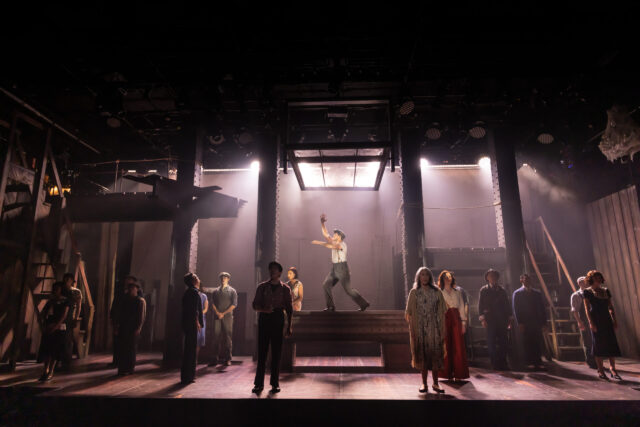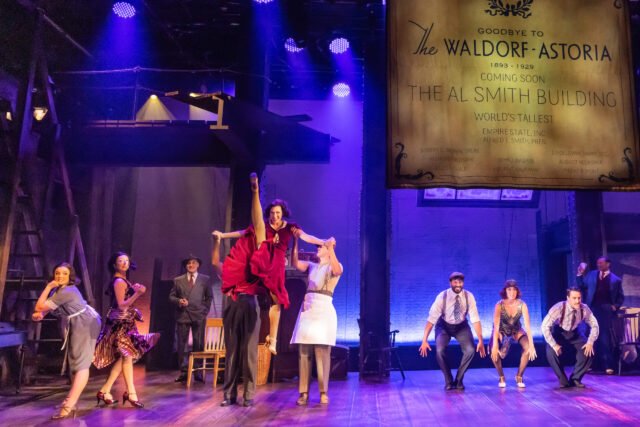
Empire: The Musical follows the construcion of the Empire State Building in head-scratching ways (photo by Matthew Murphy)
EMPIRE: THE MUSICAL
New World Stages
340 West Fiftieth St. between Eighth & Ninth Aves.
Wednesday – Monday through September 22, $58-$144
empirethemusical.com
newworldstages.com
In March 1965, Andy Warhol released Empire, an eight-hour film consisting of a single, static shot of the 102-story Empire State Building, on Fifth Ave. and Thirty-Fourth St., taken from the forty-first floor of the Time & Life Building on Sixth Ave. between Fiftieth and Fifty-First Sts. Some years ago, I recall reading about how at one screening, a theater, in an effort to encourage audience members to sit through the whole black-and-white silent film, offered to return some of the cost of the ticket based on how long people stayed; patrons who made it to the end got all their money back.
Alas, that is not the case with the shockingly drab and clueless Empire: The Musical, which opened tonight at New World Stages on West Fiftieth St., just a few blocks away from the former Time & Life Building and the Empire State Building (ESB) itself.
Caroline Sherman and Robert Hull started writing the show in 1999, and it debuted at the Hudson Backstage Theatre in Hollywood in 2003. A revised version ran at La Mirada Theatre in California in 2016. This latest iteration is scheduled to continue through September 22, testing the audience’s patience to make it through all two and a half interminable hours, without the possibility of getting any money back.
In a 1964 discussion recorded in filmmaker Jonas Mekas’s journal, Warhol declared, “The Empire State Building is a star!” Sherman and Hull, who previously collaborated on such shows as Goodney’s Ghost, Byzantium, and Diggy Hoffen Pepper Zee and the Colors of the Rainbow, essentially leave the ESB out of the musical. Never once is their any indication of its Art Deco majesty, and although they mention photographer Lewis Hine, none of his famous photos documenting the development are shown.
Instead, the narrative focuses on individuals involved in the construction of the skyscraper, which began in March 1930 in the midst of the Great Depression. Former New York State governor and presidential candidate Alfred E. Smith (Paul Salvatoriello), business executive and Smith supporter John J. Raskob (Howard Kaye), and New York City mayor Jimmy Walker (Devin Cortez), who are real, appear along with a bevy of invented characters who are meant to represent various issues that arose during the 410 days it took to build the structure.
The frame story introduces three generations of a Mohawk family: Sylvie Lee (Jessica Ranville, but we saw understudy Julia Louise Hosack), who is onstage the entire show, watching, commenting on, and participating in the action across eras, from 1930 to 1976; her father, Joe Pakulski (Cortez), who died while working on the building; Joe’s wife, Rudy Shaw (Kiana Kabeary), who disguises herself as a man so she can work next to her husband; and Sylvie’s daughter, Rayne (Kiana Kabeary), who wants to follow in her grandparents’ footsteps. It feels forced, turning the show into a private quest and a way to deal with the inherent prejudice against the immigrants on the crew: the Italian Paolo De Caprio (Ethan Saviet), the Polish Pakulski, and the Irish Ethan O’Dowd (J Savage), regularly insulted by the bigoted Matteo Menzo (Robbie Serrano).
The mundane dialogue also overuses the metaphor of each story of the ESB relating to each worker’s story. As Charles needlessly explains, “We write stories, we build stories. It’s no coincidence, you know. Folk tales were passed down verbally so as a memory device, chapters were rooms of a house and each story a floor.” Sylvie responds, “Stories and stories.”
One of the main figures, Frances Belle “Wally” Wolodsky (Kaitlyn Davidson), Smith’s impressive right-hand assistant, is invented, an amalgamation of Frances Perkins, the first woman to serve in a presidential cabinet, and trailblazing civic reformer Belle Moskowitz. Architect Charles Kinney (Albert Guerzon) is a combination of designers from the firm of Shreve, Lamb & Harmon, including Japanese American Yasuo Matsui. There appears to be no evidence that a woman pretended to be a man in order to work on the Empire State Building. And although at least five men were killed while the site went up, none of them was named Pakulski and married to a Native American woman. All of this fiction detracts from the story, which barely mentions the historic “Race to the Sky” between the ESB and the Chrysler Building; instead, we get tons of metaphors about going up and going down.

Empire: The Musical is not quite a “ring-a-ding-zing” show (photo by Matthew Murphy)
The forgettable songs, played by a seven-piece band led by conductor and keyboardist Gillian Berkowitz, have such titles as “Don’t Look Down When You’re Going Up,” “Touch the Sky,” and “Castles in the Air,” featuring such lyrics as “Why must I justify who I am / Don’t they see, this is me, they don’t give a damn / I have tried to dignify our battle cry / To reach so high we’d touch the sky, why wouldn’t I,” “You just need to understand that I’m not the kind of man / Who can live my life on the ground / When here and now I’ve finally found / My place up in the air, don’t worry I hear you,” and “Heyday, we’ll have our say day / Our ring-a-ding-zing day will light the night.”
And then there’s Smith’s secret to success, “Moxie”:
Raskob: I’ll get you back up on top.
Smith: My new building will be la crème de la crop.
Charles: Right, my — your — building will make the skyline pop / What’s the hullabaloo?
Smith/Raskob/Charles: It’s not just ballyhoo / We’ve got moxie and a melting pot of can do.
Empire: The Musical is flatly directed by Cady Huffman, who has been nominated for two acting Tonys, winning Best Featured Actress in a Musical in 2001 for her role as Ulla in The Producers. Lorna Ventura’s choreography and Tina McCartney’s costumes lack imagination, while Walt Spangler’s scenic design is a mix of erector set and Lego blocks; a vertical window at the center rear of the stage sometimes tilts down at a forty-five-degree angle, then goes back up, for no apparent reason. There are no visual clues that this is the Empire State Building; it could be any large tower anywhere.
Every night, when I tuck myself into bed, I can see the top of the ESB, which is currently the fifty-sixth tallest building in the world. There must be a lot of great stories to be told about it, but Empire: The Musical is not one of them. In the meantime, I might just try to find Warhol’s 485-minute masterpiece online and see how much of it I make it through.
[Mark Rifkin is a Brooklyn-born, Manhattan-based writer and editor; you can follow him on Substack here.]